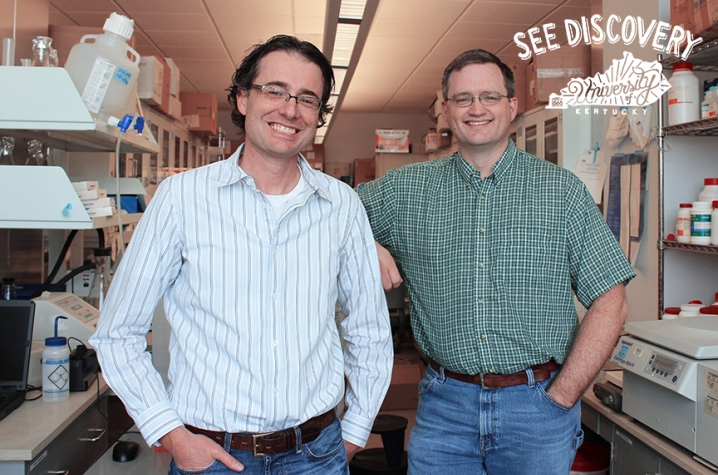Following a Scientific Trail Leads UK Researchers to Opportunities in Medicine, Agriculture and Business

LEXINGTON, Ky. (Aug. 12, 2014) — University of Kentucky associate professor Dr. Matthew Gentry, a biochemist who studies the very basic makeup of living things, can count very few "Eureka!" moments in his scientific career.
One of those moments occurred while he was studying the genetic mutation associated with Lafora's disease, a type of epilepsy that inevitably causes death from neurodegeneration early in life. He was conducting post-doctoral research at University of California-San Diego to determine what happens within the cells of children born with Lafora's disease. He was examining the role of the protein laforin, the mutation that causes the disease. He and a colleague performed a series of biomedical experiments, but their trials weren't giving insight into the molecular behavior of the disease.
Desperate for answers, the researchers consulted literature about the disease from the 1960s. They uncovered a commonality between a protein in plants, called Starch Excess4, and the human protein that causes Lafora’s disease. They found that the plant protein modifies carbohydrates and that the human protein laforin mirrors this behavior. This discovery provided a framework that medical researchers use today to test potential therapies for Lafora's disease.
The moment of gratification came when Gentry was testing whether the Lafora's disease protein would model the behavior of the plant protein. Gentry and his colleague were so thrilled with the initial test results that they returned to the lab that same night to repeat and verify the experiment.
"I knew we had the answer at that point," Gentry said. "We figured out what was going wrong, and that gave us the first idea of potentially how these kids could be treated. And we've been following those leads since then."
In 2008, Gentry brought his research on Lafora's disease to the University of Kentucky where he has continued to explore the link between plant and human biology in his laboratory. While his initial discovery was a step forward in the quest to cure a devastating disease, Gentry's biomedical research has provided a path into new opportunities to uncover new information about plant molecules and start a business venture with fellow UK faculty member Dr. Craig Vander Kooi. Gentry spends half of his time working on potential therapies for Lafora's disease, and the other half of his time studying how these proteins impact plant metabolism and the industrial processes related to plant products.
Since coming to UK, Gentry has collaborated with Vander Kooi, an associate professor of biochemistry, to decode the function of Starch Excess4, the plant protein Gentry initially identified. Gentry and Vander Kooi received funding from the National Institutes of Health for biomedical research as well as the National Science Foundation for their discoveries in plant biology. On the molecular level, Gentry said these fields complement one another, and human science has a lot to learn from plants.
"Plants are among the most fascinating generators of biomolecules on the planet," Gentry said. "Joe Chappell's lab over in (the UK College of Pharmacy) spends a lot of time looking at the amazing chemistry that plants put together — what we in the lab have struggled to do."
In the past few years, many research institutions around the world, such as the Howard Hughes Medical Institute, have also acknowledged the connection between human and plant science. Gentry said scientists have only scraped the surface knowing how plants can contribute to human medicine. Because major research funding is dedicated to curing diseases, plant science has lagged behind biomedical science for centuries.
"It was once thought that we can either work to cure a disease or we can figure out how a plant works, but we are now at the point where we see how the two start to intersect," Gentry said.
Using knowledge developed through their plant research, Gentry and Vander Kooi have mapped the three-dimensional structures of multiple proteins. This type of access to the structure has allowed them to engineer natural ways of modifying starch. They believe their discovery of the Starch Excess4 enzyme will lead to more natural, environmentally friendly and cost-efficient methods of breaking down starch for myriad industrial purposes, with applications in manufacturing, agriculture and biotechnology.
Gentry and Vander Kooi recently acquired patents for their discoveries, including the Starch Excess4 enzyme, and are now developing a small business venture together that will translate their research to commercial uses. Starch is an important component in the production of glue, plastics, clothing and animal feed; and breaking down starch requires expensive processes in manufacturing that often produce excess waste. Their business will help potential customers in the manufacturing industry implement "green" and cost-effective methods of breaking down starch. Gentry never planned to begin a small business enterprise, but he said he's simply followed the science to whatever end.
"You just kind of go where the science takes you," Gentry said. "It's fun that you never know exactly where you're going. You understand the experiments you're doing, you understand the results you're getting. But you don't know where that's going to lead you."
MEDIA CONTACT: Elizabeth Adams, elizabethadams@uky.edu; (859) 940-8104




